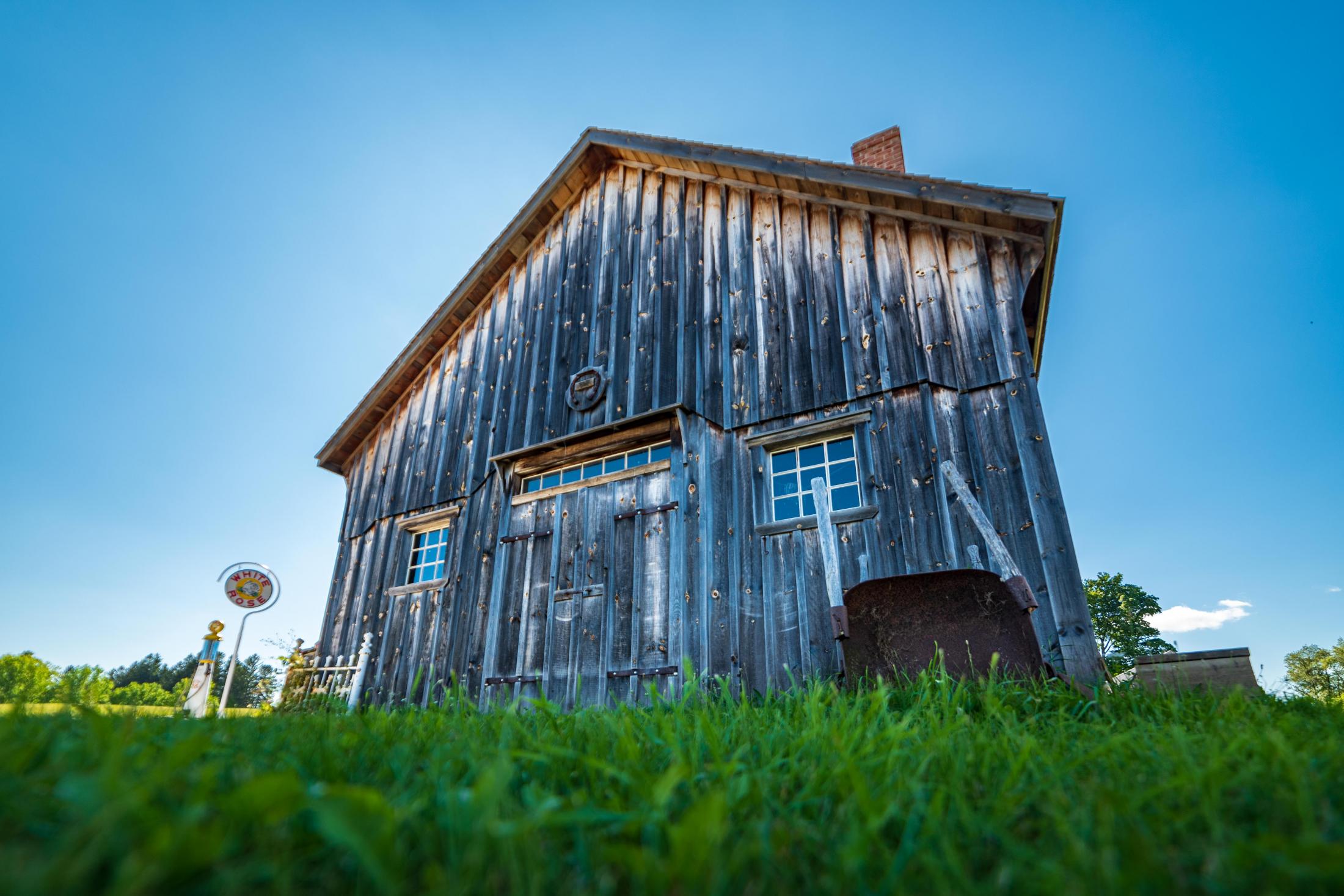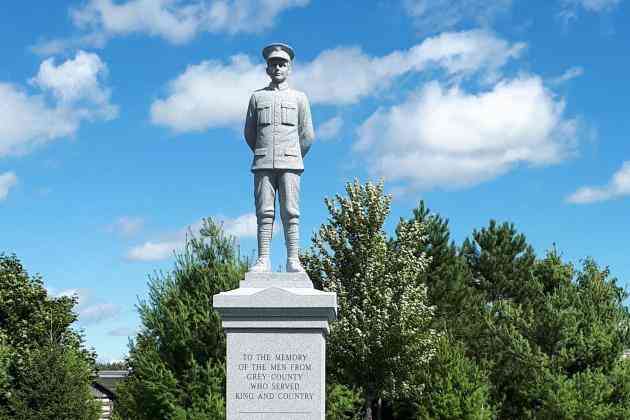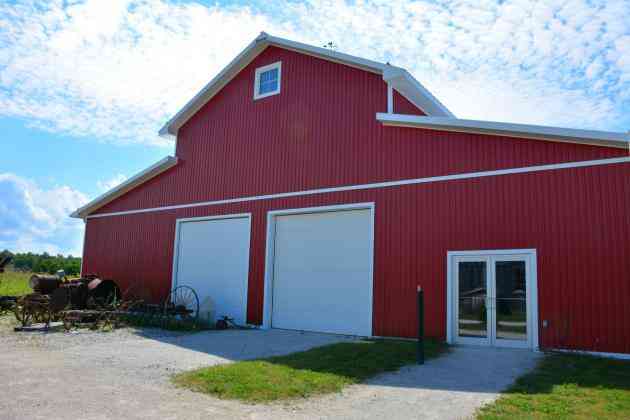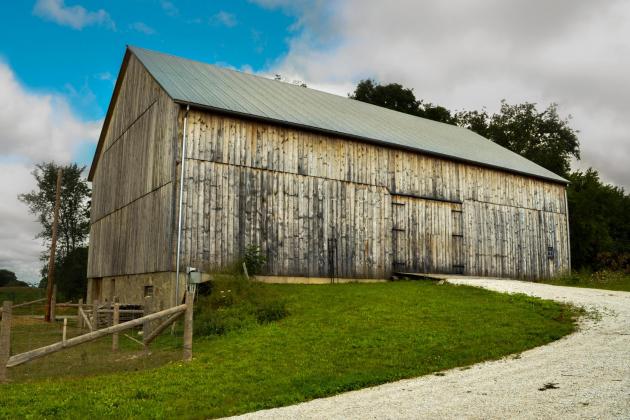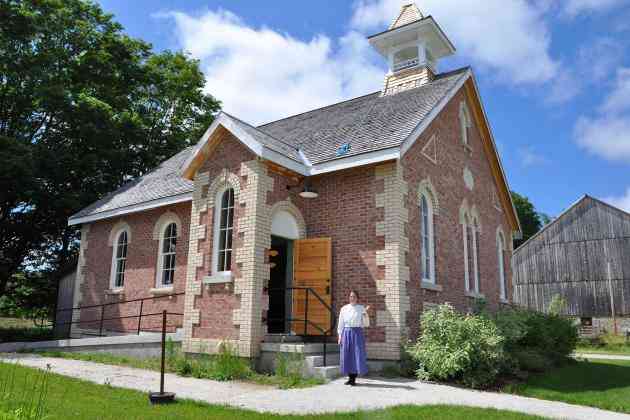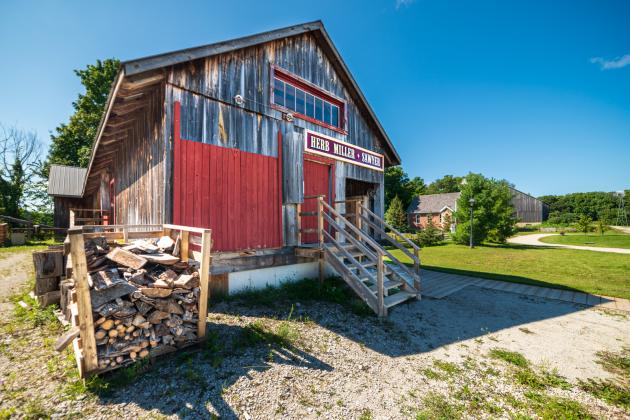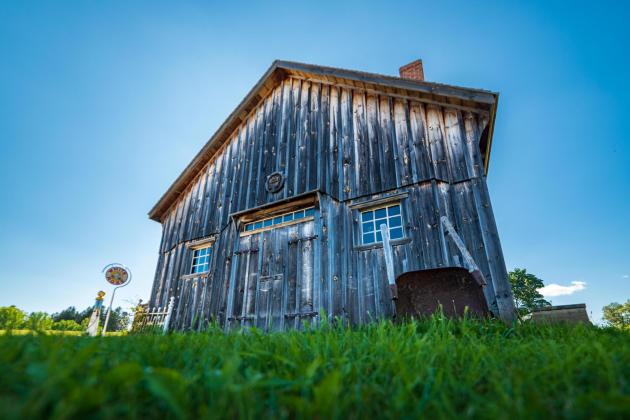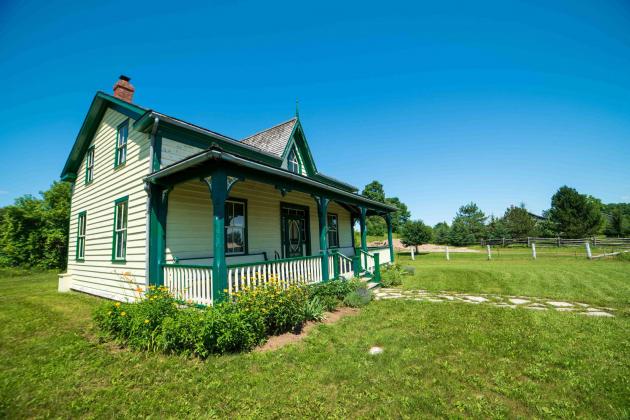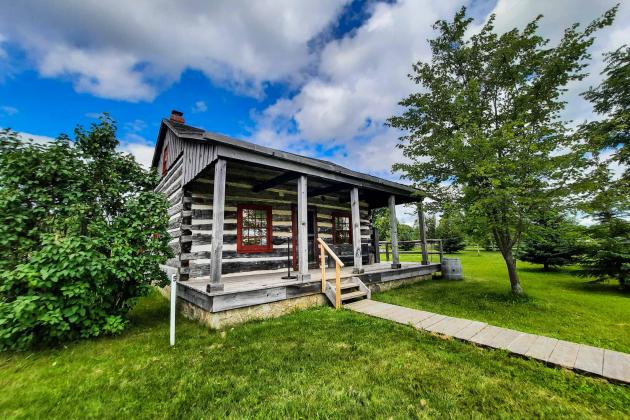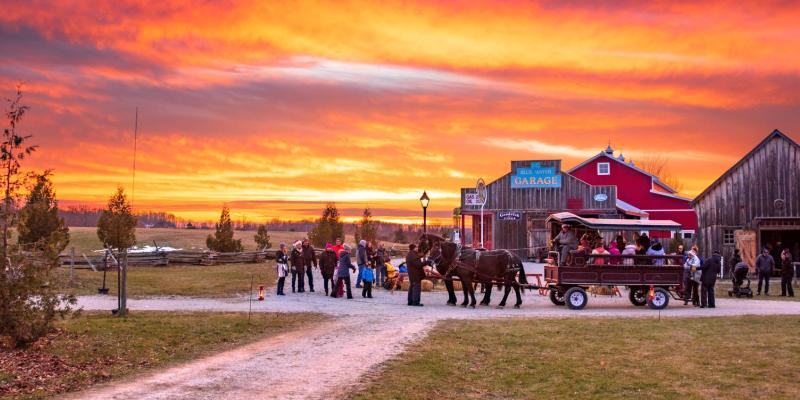1920s George Rice Blacksmith Shop
This timber-framed structure, which opened in June 2010, is made of reclaimed timbers from Grey County buildings. It is a 24 foot x 32 foot storey-and-a-half board and batten-sided structure, with a gable roof. There is an oversized horseshoe trade sign hung on the front, inspired by the sign that George Rice (1892-1964) had on his blacksmith shop at Massie, Grey County.
The project was initiated and funded by the children of George and Jessie Rice. The structure differs from Rice's original shop, but replicates a rural blacksmith shop with a "shoeing floor" and enough space for blacksmithing, farrier and early mechanical work.
It is a functional shop, where volunteer blacksmiths demonstrate smithing for visitors and school groups. Its contents include artefacts that belonged to George Rice, as well as other Grey County blacksmiths and farriers. This blacksmith shop interprets the transition of 1920s-era blacksmithing, a time when many citizens of Grey County began driving automobiles. These newfangled machines required specialized repairs, while smiths also continued to repair horse drawn vehicles and perform custom metal work.
The Massie Blacksmith Shop
An account based on an interview with George's son, Gilbert Rice of Owen Sound and written by his granddaughter, Sharon Burnside:
Massie blacksmith George Rice learned his trade from his father, William Edward Rice (1858-1914), who had a blacksmith shop in Toronto. In 1885 he sold the shop and decided to work in lumber camps. Conditions in the camps were difficult and equipment was always breaking. Every lumber camp needed a blacksmith to fix tools, wagons, chains, and to shoe horses. So, with a wagon, his tools, a horse and his growing family, William moved from camp to camp.
His oldest daughter, Sadie, was born in Toronto; Mary Anne was born in Cataract; Emmy in Greenlaw; William in Drayton; George Gilbert Rice was born in 1892, in Montecilla; Charlotte in Elba; Frank in Montecilla; and Albert, in Elba.
William’s wife Sarah Jane Fenwick was artistic. In Elba, William built buggies and she painted the decorative swirls and pin stripes on them. She died when Albert, who was born in 1903, was an infant. William moved north in 1910 and settled the family in a house on 3rd Ave. East in Owen Sound. When the Massie blacksmith shop was offered for sale, William bought the shop and a nearby farm at the 4th Line and Massie Road. William died in 1914. William’s son, Will, took over the farm and his son George Rice took over the shop.
Horses needed their shoes replaced about every three months. Roughed out horseshoes were bought in a keg from wholesalers and George would then custom fit them. The horses’ hooves were shaved (they grow like fingernails), and the shoes were held with tongs and heated in the fire of the forge until the metal was soft enough to shape by hammering it on an anvil. If it was winter, toe and heel plates on the shoes were sharpened for traction; the hot shoe would be dipped in a barrel of water to cool it down, then nailed to the horse’s hoof. The hoof is dense and does not have nerves, so this does not hurt the horse.
Work horses that pulled logs, ploughs and stone boats* had heavier shoes than “road horses” that pulled buggies. The work horses were easier to shoe because they were quieter. In the 1930s, wild horses from the Prairies were brought to the area and were popular with local farmers because they were cheaper than tamed horses. Some blacksmiths had cages for more high-spirited horses, but George did not use a cage.
George made many things from metal - tools, hooks for chains, garden gates, rims for wagon wheels, handles for stove tops, parts for sleighs - whatever people needed. This was not enough to keep the business going, so in 1925 George decided to diversify. He drove to Markdale and bought a number of woodworking machines - a jointer, a band saw, a rip saw and a lathe. He took the motor out of his 1917 Ford and would attach a belt from the car motor to the machine he wanted to use - his fingers crossed that the temperamental engine would run.
This allowed to him to branch out. He could now turn handles for tools, baseball bats, rolling pins and whiffletrees** for horses. He made stone boats, skis and farm gates of wood and metal. For his grandchildren he made rockers and doll furniture, spring horses and bobsleds. He could build or repair wagon wheels, turning the hubs, buying roughed-out spokes, custom fitting the wooden wheels with metal rims that came in two pieces.
Another sideline was sharpening - tools, knives and saws of all sorts. After sharpening cross-cut saws he tested them - with one of his sons' help - offering copious advice on proper sawing technique. During the Second World War he sharpened and tempered tools for Kennedy’s Foundry in Owen Sound.
The metal George used came from a wholesaler in Guelph and from Christie Brothers Hardware in Owen Sound. A lot of the metal came in 10-foot lengths. George would drive his 1929 Hudson to Owen Sound early in the morning, strap the lengths of metal onto the fenders and be back in Massie in time to open the shop at 9.
He bought wood from Harry Gardiner, who had several area bush lots: white ash for farm gates, as well as ironwood, fence elm and pine.
Blacksmithing was competitive. In those days there were shops in Bognor, Holland Centre and two blacksmiths in Chatsworth, so you needed to get along with your neighbours and be active in the community. The work was hard, but you could make a living.
George and Jessie Root, a teacher, married in 1925 and soon had a large family to look after - Gilbert, Brian, Lois, Yvonne, Ted and Jack. Gilbert’s first job, at the age of four, was ferrying messages or cold drinks from home, which was at the top of the west hill of the hamlet, to his dad in the shop down the hill toward the main corner and across the road from the pond and the mill. Each night after dinner, George and Jessie would record the day’s business in a ledger, keeping track of their expenses and what their customers owed them.
“You made a deal on a handshake,” Gilbert said. If customers could not pay, George would take the car and go door to door in the evening and try to collect. Sometimes he was paid with apples or potatoes. Gilbert worked with his father and was paid the same wage that his brother Brian earned working in the Massie General Store - about $3 a week.
Blacksmithing was a very physical job - you had to be in good shape to wield the heavy tools needed to bend and shape the metal. It was hot and dirty work. The forge was an open fire, fuelled with soft coal and oxygen from a hand-cranked blower. George’s hands were black when he finished his day’s work and no amount of hard scrubbing in the kitchen basin, using water warmed in the reservoir of the wood stove, could get them completely clean.
George was a Baptist, Jessie an Anglican, so they compromised and joined the Massie United Church. The family was musical. Jessie taught her children piano and sent them for violin lessons. George played the autoharp and loved to sing. He had a bass voice and sang with a male quartet and in a family quartet with his sisters Charlotte and Mary and his brother Albert. George and his children - who played piano, violin, banjo, guitar and sang - entertained at local dances.
George died in 1964; he was 72. The tobacco he loved to smoke and the smokey atmosphere of the shop caught up with him. The shop in Massie is gone now but the tools George made are still used in the George Rice Blacksmith Shop in Moreston Village at Grey Roots Museum and Archives. His hand made gifts are still used and cherished by his family.
*Stone boats: A type of sled for moving heavy objects. Originally, they were pulled by horses or oxen to clear fields of stones.
**Whiffletrees: The pivoted swinging bar to which the traces of a harness are fastened and by which a vehicle or implement were drawn.

